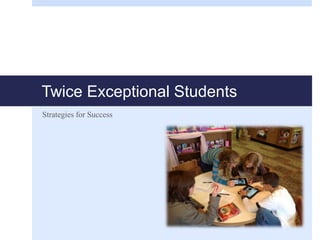
Twice exceptional students
- 1. Twice Exceptional Students Strategies for Success
- 2. Who are 2E Students? 2E or twice exceptional students are students who have a high cognitive ability in addition to areas of challenge or disability. Of the 13 disability categories identified under IDEA all but one (mental retardation) can exist simultaneously with cognitive gifts. These students are difficult to identify because their gifts often mask their disability. This makes them at risk for not reaching their true potential. Source
- 3. Some Common 2E Combinations
- 4. Strategies for Success with 2E Students Twice exceptional students have learning profiles that are uneven; sometimes these students shine and sometimes they struggle. We can use the three key principles of learning to maximize their strengths and support their areas of challenge or disability. Source
- 5. Three Key Principles of Learning Activate the students’ prior knowledge. Help them build conceptual frameworks that organize fragmented ideas into meaningful wholes. Help them develop self-regulatory, intentional approaches to learning. Source
- 6. Individuals do not Learn at the Same Rate How can we begin to use time more flexibly and provide more time for students who need it while allowing others to progress more quickly? Dynamic Assessment These are brief conversations or formative assessments to discover what your students know, what they do not yet know, and what misconceptions they have. Source
- 7. Allow 2E Students Extended Time to Process Information This can be done by tiering assignments. Using the Universal Design Theory provide multiple access and ways to interact with information. Some Students need more practice to master the basics. Some students need to focus on enrichment or challenging activities.
- 8. Teaching to Conceptual Frameworks Conceptual Frameworks Less is More! Take fewer conceptual ideas deeper into the curriculum. Identifying the big ideas allows students to concentrate on the most important learning activities. For example instead of completing 15 similar math problems for homework. Students can finish one problem and then write a reflective analysis. Reflective Analysis Example Assign one math problem for homework The student solves the math problem and then answers the following reflective questions about the problem How and why they used this method to solve the problem. Where this kind of math might be useful in real life. What they learned about solving this problem that they can apply to future problem-solving
- 9. Use Graphic Organizers The use of graphic organizers is a critical instructional strategy which allows students to connect ideas, both new information and prior knowledge. Graphic organizers or web maps can be edited and changed as learning occurs allowing students to reflect on the process of learning. This teaches metacognitive awareness allowing students to be in control of their own learning. Source
- 10. Structure of Learning Environments Students need time to think about what they know and how the new information fits into what they already know. Students need time to write out these ideas in a diagram, graphic organizer or concept map. Students need time to collaborate with peers, talk it out with a partner or small group and reevaluate their thinking. Students need to see you use the metacognitive approach so they can learn through the process of modeling.
- 11. Advocacy and Emotional Support Twice exceptional students need to learn self advocacy skills. They need to understand their strengths as well as their challenges and find ways to share this information with their teachers. It is important that with twice exceptional learners especially those with learning disabilities that we maintain the complexity of learning. If you decrease the complexity of learning this undermines the 2E student. Keep the complexity level high while adjusting time, structure of learning, and offering additional support. Source
- 12. Technology Integration Technology can be used to support the challenges twice exceptional students face. Technology can be used to nurture the gifts of the twice exceptional student. Technology can provide multiple means of acquiring information, conceptual understanding, as well as, multiple ways to show what they have learned. Source
- 13. Final Thoughts “ Even our most gifted students with learning disabilities need us to teach with clarity, to make ideas explicit, and to build the relationships across ideas to anchor learning. As we work to meet the needs of our twice-exceptional students we increase our power to reach all our students.” (Colman, 2005)
- 14. References Baum, S. M. (2004). Twice-exceptional and special populations of gifted students. Thousand Oaks, CA: Corwin Press. Berninger, V. W., & Abbott, R. D. (2013). Differences Between Children With Dyslexia Who Are and Are Not Gifted in Verbal Reasoning. Gifted Child Quarterly, 57(4), 223-233. doi:10.1177/0016986213500342 Coleman, M. (2005). Academic Strategies That Work for Gifted Students With Learning Disabilities. Teaching Exceptional Children, 38(1), 28-32. Retrieved February 26, 2015, from http://www.iag-online.org/resources/LD/Professional/Mary-Ruth- Coleman-article.pdf Nicpon, M. F., Allmon, A., Sieck, B., & Stinson, R. D. (2011). Empirical Investigation of Twice-Exceptionality: Where Have We Been and Where Are We Going? Gifted Child Quarterly, 55(1), 3-17. doi:10.1177/0016986210382575 Sue, J., Linda, B., Betty Roffman, S., & Rich, W. (2008). Bordering on Excellence: A Teaching Tool for Twice-Exceptional Students. Gifted Child Today, 31(2), 40-46. Retrieved February 21, 2015, from http://eric.ed.gov/?id=EJ789920 Yates, C. M., Berninger, V. W., & Abbott, R. D. (1995). Specific Writing Disabilities in Intellectually Gifted Children. Journal for the Education of the Gifted, 18(2), 131-155. doi:10.1177/016235329501800203